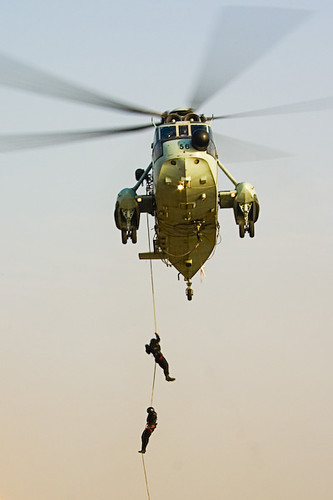 Indian Navy Commandoes Chase Away Somalian Pirates
Indian Navy Commandoes Chase Away Somalian Pirates
(NSI News Source Info) November 13, 2008: The Indian navy came to rescue of a thirteen year old, 71,000 DWT (deadweight ton) Indian bulk carrier in the Gulf of Aden. The 700 foot long "Jag Arnav" was surrounded by several speed boats full of armed pirates, who were trying to get close enough to the moving ship to climb aboard. The merchant ship, which wasn't fast enough to outrun the pirates, sent out a distress signal, and the Indian frigate Tabar, which was about 50 kilometers away, responded. Since it would take an hour for the warship to reach the scene, the Tabar launched its 5.5 ton Dhruv helicopter. Similar to the UH-60, the only weapons a Dhruv usually carries are missiles, but it can also carry up to a dozen passengers, and in this case it had marine commandos on board. The helicopter was on the scene within fifteen minutes, and the pirates fled.
The Gulf of Aden is one the busiest shipping lanes in the world (with nearly ten percent of global traffic). Each month, 1500-1600 ships pass the northern coast of Somalia. So far this year, 2-4 of those ships have been seized by pirates each month. That's one ship out of every 400-500. But with the pirates getting more and more ransom money for each ship, the number of pirate groups operating in the Gulf of Aden is increasing. It's believed that at least three fishing trawlers (able to stay out for weeks at a time, and carry speed boats for attacks) are acting as mother ships for the pirates. Most merchant ships are wary of pirate operations, and put on extra lookouts, and often transit the 1,500 kilometer long Gulf of Aden at high speed (even though this costs them thousands of dollars in additional fuel). The pirates seek the slower moving, apparently unwary, ships, and go after them before they can speed up enough to get away. For the pirates, business is booming, and ransoms are going up. Pirates are now demanding $2-3 million per ship, and are liable to get it for the much larger tankers and bulk carriers they are now seizing.
An international naval task force has set up a patrolled corridor through the Gulf of Aden, and advised slower ships to travel in convoys (which will get extra attention from the warships.) Ships are being warned to transit the Gulf of Aden carefully. It's the slow moving ships, without sufficient lookouts (the speedboats are difficult to spot with the radar used by merchant ships) that are most vulnerable. Meanwhile, the government in Puntland (noreastern Somalia) appears to be intimidated, and/or bought off, by the warlords running the pirate operations along their coast.
The pirates know that the warships will not attack them unless a hijacking attempt is in progress. The Gulf of Aden is several hundred kilometers wide, so there are simply not enough warships (over two dozen at the moment) to effectively cover the entire area. Moreover, not all the ships have armed helicopters on board. So the pirates will keep at it.



















No comments:
Post a Comment